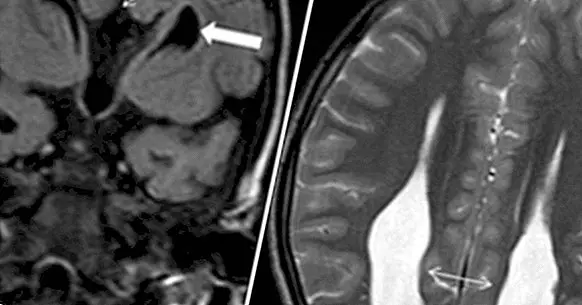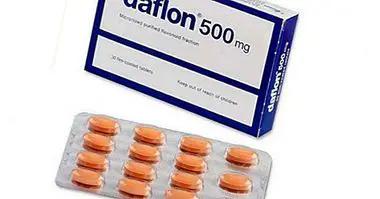Colpocephaly: what it is, causes, symptoms and treatment
There are multiple factors that can cause defects in brain formation during intrauterine development or later, such as contact with toxic substances or the inheritance of genetic mutations.
In this article we will describe the causes, symptoms and treatment of colpocephaly , a rare disorder of brain development.
- Related article: "The 15 most frequent neurological disorders"
What is colpocephaly?
Colpocephaly is a congenital morphological abnormality of the brain that is characterized by a disproportionately large size of the occipital horns of the lateral ventricles , the cavities through which the cerebrospinal fluid circulates, which fulfills functions similar to those of the blood inside the skull. It can be due to different brain disorders.
The term "colpocephaly" was coined in 1946 by neurologist Paul Ivan Yakovlev and neuropathologist Richard C. Wadsworth. The words "kephalos" and "kolpos" come from the Greek and can be translated as "head" and "hollow", respectively. This disorder had been described 6 years earlier by Benda, who gave it the name "vesiculocephaly".
Colpocephaly is part of the set of structural alterations that are known as "cephalic disorders" . By definition this category encompasses all anomalies and damages that affect the head and especially the brain, such as anencephaly, lissencephaly, macrocephaly, microcephaly and schizencephaly.
In any case, it is a very rare disorder. Although there are no precise data on the prevalence of colpocephaly, between 1940, the year in which it was first described, and 2013, only 50 cases had been identified in the medical literature.
It is important to distinguish colpocephaly from hydrocephalus , consisting of an accumulation of cerebrospinal fluid in the brain that causes symptoms derived from increased cranial pressure. Cases of colpocephaly are often misdiagnosed as hydrocephalus, and treatment of this disorder can lead to signs of colpocephaly.
Causes of this alteration
The causes of colpocephaly are varied, although they always interfere with the development of the brain causing the white matter (the set of fibers formed by axons of neurons) to have a density lower than normal. This causes, at the same time as it indicates, an altered functioning of the transmission of electrochemical impulses in the brain.
Between the most common causes of colpocephaly We find the following:
- Genetic defects such as trisomies of chromosomes 8 and 9
- Recessive inheritance associated with the X chromosome
- Alterations in the neuronal migration process
- Contact with teratogens during intrauterine development (eg alcohol, corticosteroids)
- Perinatal cephalic lesions (eg, ischemic anoxia)
- Hydrocephalus and sequelae of its treatment
- Absence (agenesis) or incomplete development (dysgenesis) of the corpus callosum
- Other disorders of the central nervous system and its development
Symptoms and main signs
The fundamental sign of colpocephaly is the disproportionate size of the occipital horns of the lateral ventricles compared to the rest of its sections. This indicates a slowing down of the development of the brain, or an arrest of it at an early stage.
Colpocephaly usually does not occur in isolation, but in general occurs along with other disorders that affect the central nervous system , especially its development. These include microcephaly, lissencephaly, agenesis, dysgenesis and lipoma of the corpus callosum, schizencephaly, cerebellar atrophy or Chiari malformations.
Nerve disorders can cause various symptoms and signs, among which highlight cognitive deficits, motor dysfunctions, the appearance of seizures and muscle spasms, alterations in language and visual and auditory deficits. A frequently associated morphological anomaly is the reduced size of the head (microcephaly).
However, and given that the severity of the morphological abnormalities that cause colpocephaly differs depending on the case, sometimes this disorder does not involve symptoms or they have a relatively mild character.
Treatment of colpocephaly
The prognosis in cases of colpocephaly can vary greatly depending on the severity of the underlying and associated brain disorders, given that this anomaly is usually a sign of other disorders of greater clinical significance. The severity of most brain changes depends on the degree to which the neural development is affected.
There is no specific treatment for colpocephaly , since it is a structural disorder of the brain. Therapy, therefore, tends to be symptomatic; thus, for example, antiepileptic drugs are prescribed to prevent seizures and physical therapy is used to minimize muscular contractures and motor problems.
Many are currently being carried out research around the development of the brain and in particular to neurulation , the process of development of the neural tube, from which the nervous system is formed. It is expected that increasing knowledge about genes and relevant teratogenic factors reduces the risk of colpocephaly in the general population.
A particularly promising treatment line is that which refers to the use of stem cells; In particular, we are investigating the possibility of using oligodendrocytes (a type of neuroglia) to enhance the synthesis of myelin, which lines the neuronal axons and accelerates neuronal transmission; this could alleviate the symptoms of colpocephaly.
Bibliographic references:
- Benda, C. E. (1940). Microcephaly American Journal of Psychiatry, 97: 1135-46.
- Puvabanditsin, S., Garrow, E., Ostrerov, Y., Trucanu, D., Ilic, M. & Cholenkeril, J. V. (2006). Colpocephaly: a case report. American Journal of Perinatology, 23 (5): 295-297.
- Yakovlev, P. I. & Wadsworth, R. C. (1946). Schizencephalies: a study of the congenital clefts in the cerebral mantle: I. Clefts with fused lips. Journal of Neuropathology and Experimental Neurology, 5: 116-130.



















